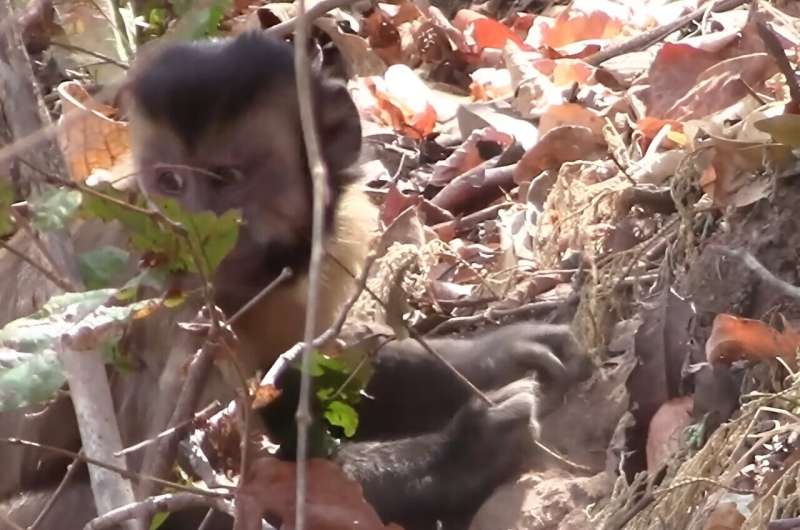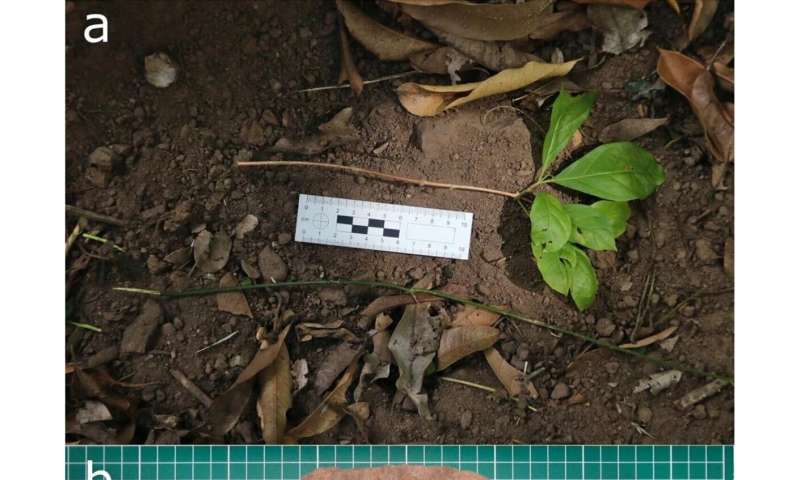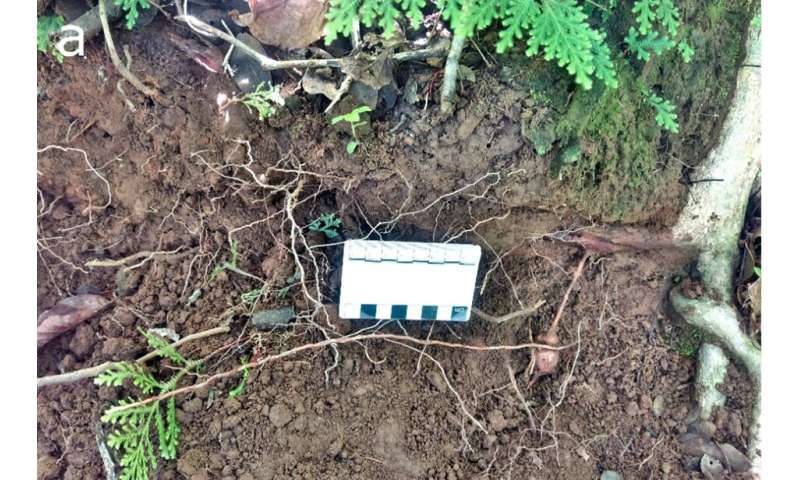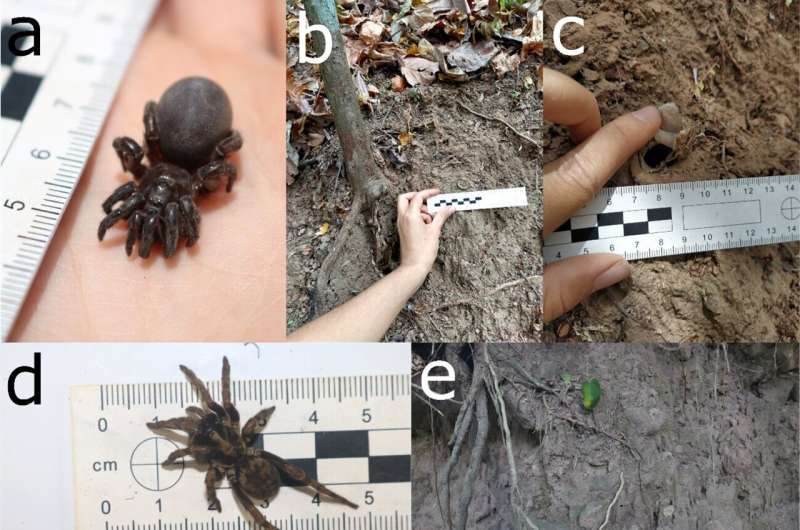May 14, 2024 feature
This article has been reviewed according to Science X's editorial process and policies. Editors have highlighted the following attributes while ensuring the content's credibility:
fact-checked
peer-reviewed publication
trusted source
proofread
Study shows that capuchin monkeys use sticks and stones to dig for food underground

Capuchin monkeys are omnivores whose diet in the wild may include buds, flowers, leaves, seeds, nuts, fruit, and berries; as well as birds, eggs, small mammals, mollusks and arthropods such as insects and spiders.
Some of these food sources are found underground, and using tools could help the monkeys locate and access them. It is known that chimpanzees (Pan troglodytes) in the wild use sticks to dig for underground plant storage organs (bulbs, corms, taproots and tubers), but little research exists on how capuchins obtain food from underground.
Now a research team from the University of São Paulo and the Capuchin Culture Project in Brazil, and Germany's Max Planck Institute of Animal Behavior and Max Planck Institute for Evolutionary Anthropology has explored how bearded capuchins (Sapajus libidinosus, formerly Cebus libidinosus) in the wild access underground food sources. A paper describing the team's findings appears in Scientific Reports.
Sticks and stones as tools for capuchins
Bearded capuchins are known to use stones as hammers to help them crack open encased fruits and nuts.
A 2009 study was the first to report observations of a population of bearded capuchins in Brazil's Serra da Capivara National Park, an area of dry savanna, additionally using stones to find and access underground food, and to "habitually modify and use sticks as probes to dip for honey and expel prey (such as lizards, bees, and scorpions) from rock crevices and trunks, and occasionally for other resources," according to the paper in Scientific Reports.
Importantly, this new work provides the first report of bearded capuchins using sticks as probes to locate food underground. The researchers of the new study spent 21 months observing a group of bearded capuchins, this one in Brazil's Ubajara National Park, an area of wetter savanna.
Among the 31 individuals (adults and sub-adults only; no juveniles) in the group, the team recorded a total of 214 instances that the monkeys used either tools or only their hands to dig underground for trapdoor spiders (Idiops sertania and Neodiplothele sp.) and underground storage organs, described in the paper as "tuberous roots with reddish-brown skin that the monkeys peel with their hands and teeth before consuming the flesh."
Stone tool use by the numbers
The monkeys used implements from among a group of 50 stone tools for just over half (51.4%) of their attempts to dig, with a success rate of 31.8%. Using only their hands brought them more success (40.4%). Of their digging attempts for underground storage organs, 59% involved the use of stones, while they used stones in 48% of their attempts to dig out spider burrows.
-

Tools used by the capuchin monkeys at Ubajara National Park. (a) Stick tools used to probe trapdoor spider; (b) digging stones used to excavate underground food. Scale: 10 cm. Credit: Scientific Reports (2024). DOI: 10.1038/s41598-024-61243-8 -

(a, b) Underground storage organ excavated by the researchers during the wet period in the same site excavated by a capuchin monkey. The roots of this plant species are reddish. Although we could not determine the species yet, it is morphologically similar to farinha-seca USOs (Thiloa glaucocarpa), excavated by capuchin monkeys in Serra da Capivara National Park. Credit: Scientific Reports (2024). DOI: 10.1038/s41598-024-61243-8
The researchers observed that the monkeys used stone tools to dig in 59% of their digging attempts on hills, compared to just 24% of their digging attempts on riverbanks. Males used stone tools more frequently than did females, but the tool users' sex did not play a part in the success of their attempts.
Most of the stone tools were made of sandstone, and were considerably "smaller and lighter (average weight 128 g) than the pounding tools used for palm nut cracking (average weight 1,142 g) by the same population," the team reports.
Stick tool use by the numbers
On 40 recorded occasions, the monkeys used sticks on the ground, and in 42.5% of their attempts, they were successful. Of these 40 instances, 32 specifically targeted trapdoor spider burrows; targets of the other eight were unknown because the researchers could either not access steep digging sites or because they were unable to identify the monkeys' leftovers. In nearly half (47.5%) of these digging attempts, the monkeys used more than one stick.
The monkeys used sticks to dig in riverbanks nearly two times more frequently (63%) than they did on hills, and among 30 stick tools that the researchers measured, the average total length was 29.4 cm, while the average total thickness was 2.9 mm.

Techniques for spider capture
The researchers observed the monkeys using four techniques to capture trapdoor spiders. The monkeys also used two of these, "hands-only" and "stone-digging," to get to underground storage organs.
For spiders, the monkeys were additionally observed using "stick-probing." First they used their hands to remove the operculum covering the spider burrow, then they inserted twigs and shook them side to side, allowing them to capture the spider by forcing it out, and possibly also allowing them to extract an ootheca (egg mass).
The fourth technique for spider burrows was "stone-stick," in which the monkeys first used stone tools to minimize the depth of the burrow, before using sticks to probe or extract spiders or their egg sacs from inside.
Additional potential influences on digging behavior
The paper discusses in detail how other factors such as wet and dry seasons might affect various digging behaviors, and considers soil cohesion.
Moreover, the study presents a comprehensive comparison of bearded capuchin behaviors observed during this study in Ubajara National Park with those observed in previous studies conducted in Serra da Capivara National Park, suggesting that group cultural differences might play a role in observed behaviors.
Studies of this type are important, the researchers conclude, to help us "better comprehend the ecological pressures that may have shaped the emergence of different digging tools and techniques in the primate lineage."
More information: Tatiane Valença et al, Wild capuchin monkeys use stones and sticks to access underground food, Scientific Reports (2024). DOI: 10.1038/s41598-024-61243-8
Journal information: Scientific Reports
© 2024 Science X Network



















